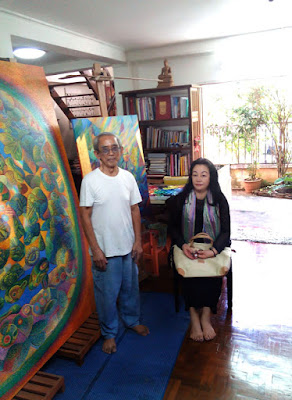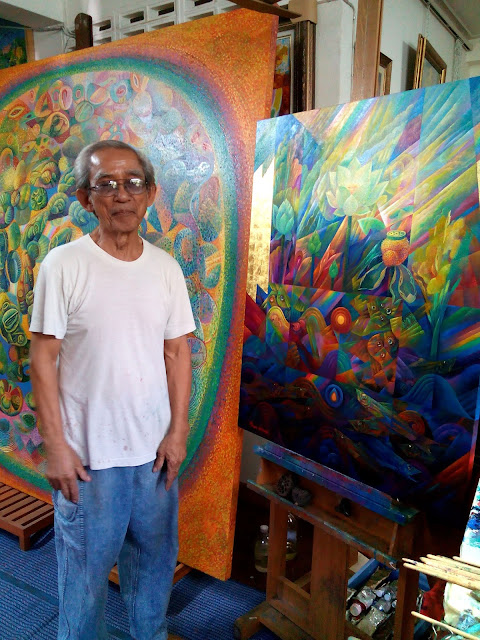Pichai Nirand :National Artist
พิชัย นิรันต์ : ศิลปินแห่งชาติ
จานีน ยโสวันต์
ท่านเป็นบุตรของเรือเอกรื่นและนางทองหล่อ นิรันต์ บิดาของท่านรับราชการเป็นทหารเรือ ท่านเกิดวันที่ 7 กุมภาพันธ์ พ.ศ. 2479 ที่กรุงเทพมหานคร
มีสิ่งที่น่าชื่นชมหลายอย่างที่ดิฉันอยากจะพูดถึงศิลปินแห่งชาติท่านนี้ คุณพิชัยนิรันต์ อย่างแรกก็คือภาพวาดสีน้ำมันของท่าน วิธีการที่ท่านสื่อความหมายโดยใช้สีน้ำมันในภาพวาดและรายละเอียดอันเฉียบแหลมที่ท่านค่อยๆใส่ลงไปในแต่และภาพนั้นมีความน่าสนใจมาก อย่างที่สองคือความอุทิศตัวของท่านต่องานศิลปะ ทุกวันนี้ท่านยังคงทำงานศิลปะอยู่ ถึงแม้ว่าคุณพิชัยจะทำงานหนักและขยัน แต่ความต้องการของนักสะสมที่ต้องการซื้อหารูปของท่านยังคงสูงมาก บางครั้งท่านใช้เวลามากกว่า 1 ปี ที่จะวาดรูปภาพรูปนึงให้เสร็จเพราะว่ามีภาพวาดอีกหลายภาพที่ต้องวาดในเวลาเดียวกันเนื่องจากมีคำร้องขอที่ยังค้างอยู่มาก ราคาภาพเขียนของท่านค่อนข้างสูงโดยเฉพาะภาพขนาดใหญ่ ซึ่งมีราคามากกว่าหนึ่งล้านบาท ท่านเป็นคนผู้หนึ่งที่มีผู้เรียกว่าศิลปินสุภาพบุรุษซึ่งได้มาจากการที่ท่านเป็นผู้ที่มีอัธยาศัยดีและสุภาพอ่อนโยน
ในวันที่พบกับคุณพิชัย ดิฉันถามท่านเกี่ยวกับวิธีการใช้สีในภาพวาด ท่านบอกว่าการใช้สีนั้นขึ้นอยู่กับความคิดจิตใจที่จะกำหนดผลลัพธ์ของงานที่อยากจะให้เป็น ในความคิดของดิฉันคำแนะนำที่ดูเรียบง่ายต้องอาศัยความรู้ที่ละเอียดลึกซึ้งและและประสบการณ์ในด้านศิลปะ ท่านบอกกับดิฉันว่าตอนที่ท่านยังเด็กท่านโชคดีมากที่เพื่อนซื้อสีที่ดีและราคาแพงจากต่างประเทศแล้วมาแบ่งกันใช้ท่านได้เข้าไปเรียนที่มหาวิทยาลัยศิลปากรและเป็นลูกศิษย์ของศาสตราจารย์ศิลป์ พีระศรีชาวอิตาเลียน ท่านมองดูภาพเก่าของท่านและเพื่อนๆแล้วพูดถึงเพื่อนบางคนในภาพที่เคยทำงานด้วยกัน หลายคนเสียชีวิตแล้วไปเนื่องจากเป็นผู้สูงวัย ท่านได้เล่าให้ดิฉันฟังถึงรูปแบบการทำงานที่เพื่อนๆท่านชอบใช้และประเภทงานศิลปะที่พวกเขาเหล่านั้นทำได้
เมื่อเพิ่มความสนใจที่มากกว่าเดิม ดิฉันมองไปที่ภาพถ่ายของคุณพิชัย เพื่อนของท่านและศาสตราจารย์ศิลป์ เพื่อนของท่านบางคนมาจากต่างคณะแต่ทุกคนก็รักงานศิลปะเช่นกัน ดิฉันบอกคุณพิชัยว่าเพื่อนท่านหน้าตาดีและทุกคนได้รับการสอนศิลปะและแนวคิดทางศิลปะในสไตล์ยุโรป จากนั้นจึงเปลี่ยนหัวข้อไปพูดถึงเรื่องอาจารย์ศิลป์ คุณพิชัยบอกว่าศาสตราจารย์ศิลป์เป็นผู้ที่อุทิศตนเองช่วยเหลือนักศึกษาที่เรียนดีแต่ยากจน คุณพิชัยก็เป็นหนึ่งในนักศึกษากลุ่มนั้นที่ศาสตราจารย์ศิลป์ช่วยเหลือทางการเงินโดยการหาทุนการศึกษาค่าเล่าเรียนและค่าอุปกรณ์วาดรูปจากบุคคลภายนอกศาสตราจารย์ศิลป์ต้องการให้คุณพิชัยจบการศึกษาจากมหาวิทยาลัยและเป็นศิลปินทึ่ดีในอนาคตเพราะศาสตราจารย์ศิลป์มองเห็นความมุ่งมั่น ความมุ่งมั่น
ความคิดสร้างสรรค์และพรสวรรค์ทางศิลปะที่หาได้ยาก
คุณพิชัยได้รับเหรียญทองแดงสาขาจิตรกรรมจากงานประกวดศิลปกรรมแห่งชาติครั้งที่ 11 ตอนที่ท่านยังเป็นนักศึกษาในปีพ.ศ. 2503 ชื่อของภาพเขียนชิ้นนั้นคือ “จุดจบ (The End)” ศาสตราจารย์ศิลป์กล่าวกับแขกที่มาในงานนิทรรศการและกล่าวชื่นชมคุณพิชัยว่า “เราเชื่อว่าศิลปินหนุ่มผู้นี้มีคุณสมบัติ ซึ่งถ้าได้นำออกมาใช้แล้วก็อาจทำงานศิลป์ได้ดียิ่ง” (ประโยคนี้ได้รับการบันทึกจากศาสตราจารย์ศิลป์ พีระศรีจากสูจิบัตรงานประกวดศิลปกรรมแห่งชาติครั้งที่ 12 ปีพ.ศ. 2504) เมื่องานนิทรรศการปีพ.ศ. 2503
จบลงอาจารย์ศิลป์ได้นำภาพนี้ไปแขวนในสำนักงานที่มหาวิทยาลัยศิลปากรและในตอนนี้ภาพนี้ก็ยังอยู่ที่เดิม
คุณพิชัย นิรันต์ไม่เคยหยุดสร้างสรรค์งานศิลปะ ท่านได้กล่าวถึงเรื่องนี้ในหนังสือหลายเล่ม “ผมรู้สึกว่าการทำงานศิลปะช่วยให้ผมตระหนักถึงคุณค่าที่แท้จริงของชีวิต ถ้าผมหยุดทำงานศิลปะ ผมคงรู้สึกเหี่ยวแห้งอับเฉา” ในปัจจุบันนี้คุณพิชัยงานของคุณพิชัยจะเน้นไปที่รูปรอยพระพุทธบาทที่มีสีสันสดใส และปรัชญาทางศาสนาพุทธ ภาพเหล่านี้จะเป็นภาพนามธรรมแต่ภาพบางส่วนก็เป็นภาพวิวทิวทัศน์และภาพดอกไม้ เมื่อมองไปยังภาพเหล่านี้เราเห็นว่าดอกบัวบาน นก และปลาเป็นสัญลักษณ์ที่ท่านใช้ในงานเขียนหลายชิ้นซึ่งมีความหมายบอกเป็นนัยถึงคำสอนของพระพุทธเจ้าเช่นวงจรชีวิตของมนุษย์และ
สัตว์ และภาพพระพุทธรูป ท่านเป็นผู้ริเริ่มแนวคิดวาดภาพรอยพระพุทธบาทผลงานที่เป็นที่รู้จักก็คือ วัฏจักรแห่งชีวิต (ภาพเขียน) ดวงตาธรรม (พ.ศ. 2548งานประติมากรรม) เจตสิกนคร (พ.ศ. 2550 สื่อผสม)
คุณพิชัยได้จัดแสดงผลงานในหลายๆประเทศเช่นประเทศญี่ปุ่นสิงคโปร์ มาเลเซีย ฟิลิปปินส์ ฝรั่งเศส สหรัฐอเมริกา (นิวยอร์ค) และกรุงปักกิ่ง (ประเทศจีน) ตั้งแต่ปี พ.ศ. 2506 – พ.ศ. 2547 หลังจากจบการศึกษาท่านเป็นครูสอนอยู่ที่วิทยาลัยช่างศิลป์และทำงานที่กรมศิลปากรจนกระทั่งได้รับตำแหน่งนายช่างศิลปกรรม ระดับ 8 ในปีพ.ศ. 2538 ท่านลาออกจากงานราชการมาเป็นศิลปินอิสระ
ต่อไปนี้เป็นการสัมภาษณ์คุณพิชัย นิรันต์ที่บ้านและสตูดิโอในจังหวัดเชียงใหม่
จานีน: ดิฉันอยากทราบเรื่องเกี่ยวกับการศึกษาด้านศิลปะ
พิชัย: ในปีพ.ศ. 2498 – 2499 ผมเริ่มต้นเรียนศิลปะที่โรงเรียนศิลปะศึกษาในกรุงเทพ ต่อมาโรงเรียนแห่งนี้ถูกเปลี่ยนชื่อเป็นวิทยาลัยช่างศิลป์ 1หลังจากที่ผมเข้าไปเรียนที่มหาวิทยาลัยศิลปากรเป็นเวลา 3 ปี ในปีพ.ศ. 2503 ผมทำงานศิลปะและได้ทำงานเป็นครูสอนศิลปะที่วิทยาลัยช่างศิลป์ ก่อนหน้านี้ผมทำงานแนวเสมือนจริงในช่วงเวลาสั้นๆ แต่ในที่สุดผมก็หันมาหางานในสไตล์ที่ผมชอบคือการเขียนภาพนามธรรม นับจากนี้ไปผมได้รวมเอาแนวคิดและ
สัญลักษณ์จากศาสนาพุทธเพื่อแสดงปรัชญาพุทธศาสนาและและคำสอนของพระพุทธเจ้า สิ่งนี้ช่วยผมได้มากในการที่จะเปลี่ยนสไตล์งานศิลปะของผมให้เน้นงานนามธรรมอิงพระพุทธศาสนา
จานีน: อยากถามคุณพิชัยเกี่ยวกับรางวัลและเกียรติยศที่ได้รับ
พิชัย: ตั้งแต่ปี พ.ศ.2503 – 2506 ผมส่งภาพเขียนในงานนิทรรศการศิลปกรรมแห่งชาติครั้งที่ 11 12 14 และ 15 ที่จัดที่กรุงเทพ ผมได้รับเหรียญทองแดงเหรียญเงิน เหรียญทอง และอีกหนึ่งเหรียญทองแดง ในปีพ.ศ. 2538 ผมได้รับเหรียญทองพระมหาชนกจากพระบาทสมเด็จพระเจ้าอยู่หัวภูมิพลอดุลยเดชและในปีพ.ศ. 2546 ผมได้รับเลือกจากกรมส่งเสริมวัฒนธรรมให้เป็นศิลปินแห่งชาติในสาขาทัศนศิลป์ (จิตรกรรม)
จานีน: ดิฉันอยากทราบเกี่ยวกับผลงานที่สำคัญที่ท่านเคยทำเพื่อ
พระพุทธศาสนาและในหลวง
พิชัย: ในปีพ.ศ. 2528-2530 ผมได้ออกแบบ 3 ใน 4 ตำบลของ
สังเวชนียสถานที่พุทธมณฑล ตำบลศาลายา อำเภอนครชัยศรี จังหวัดนครปฐม
1 โพธิบัลลังค์ สัญลักษณ์ของตำบลตรัสรู้
2 พระแท่นไสยาสน์ สัญลักษณ์ตำบลปรินิพพาน
3 พระธรรมจักร สัญลักษณ์ของตำบลพระปฐมเทศนา
ผมยังได้เป็นผู้ออกแบบสัญลักษณ์ ขยายแบบ และควบคุมการแกะสลักหินแกรนิตที่นั่นอีกด้วย
ในปีพ.ศ. 2538 ผมเป็น 1 ใน 8 ศิลปินที่ร่วมเขียนภาพประกอบหนังสือเรื่อง“พระมหาชนก” พระราชนิพนธ์ในพระบาทสมเด็จพระเจ้าอยู่หัวภูมิพลอดุลยเดชอีกงานหนึ่งคือร่วมสนับสนุนการประกวดภาพจิตรกรรม วีรกรรมหรือคุณลักษณะที่สำคัญในอดีตของทหารบก เพื่อเฉลิมพระเกียรติพระบาทสมเด็จพระเจ้าอยู่หัวทรงครองศิริราชสมบัติครบ 50 ปี จัดโดยกองทัพบก
จานีน: ท่านรู้สึกอย่างไรกับศิลปะและสังคมไทย
พิชัย: ในปัจจุบันสังคมไทยให้ความสำคัญและเข้าใจศิลปะมากกว่าในอดีต ดังจะเห็นได้ว่ามีนักสะสมงานศิลปะมากขึ้นและคุณภาพชีวิตของศิลปินก็ดีขึ้นเพราะว่าสังคมไทยเริ่มที่จะรู้คุณค่าที่แท้จริงของงานศิลปะและศิลปินก็เป็นที่เคารพนับถือ สำหรับค่านิยมกระแสหลักในอดีตพ่อแม่หลายท่านไม่สนับสนุนลูกให้เรียนศิลปะเพราะอยากให้ลูกเป็นทหาร ตำรวจ แพทย์หรือว่าเป็นนักธุรกิจและก็เป็นเพราะว่าพ่อแม่มีความเชื่อว่าอาชีพศิลปินไม่มีอนาคต ในเวลานั้นนักเรียนหลายคนที่รักในงานศิลปะอย่างแท้จริงตัดสินใจสมัครเข้าสถาบันสอน
ศิลปะทั้งๆที่พ่อแม่ไม่เห็นด้วย
ศิลปินไทยในสมัยก่อนสร้างสรรค์ผลงานศิลปะอันล้ำเลิศเพื่อพระพุทธศาสนาดังที่ได้พบเห็นจากโบราณสถานและของโบราณเก่าแก่จากหลายยุคสมัยสำหรับผมแล้วผมรู้สึกเสียดายที่สังคมไทยในตอนนี้ได้รับอิทธิพลมากจากกระแสวัตถุนิยม ศิลปินไทยหลายท่านไม่อยากจะรับรู้เกี่ยวกับความสำคัญของศิลปะโบราณหรือว่าศิลปะโบราณเกี่ยวข้องกับสังคมไทยและวิถีชีวิตอย่างไรผมรู้สึกกังวลมากว่าศิลปะไทยโบราณและความรู้ต่างๆอาจถูกลืมเลือนไปในอนาคตอันใกล้นี้ ในอีกทางหนึ่งทุกคนดูเหมือนว่าใช้ชีวิตอย่างมีความสุข
ท่ามกลางศิลปะสมัยใหม่ ที่มีทั้งเสื้อผ้า เครื่องมือ อาคาร บ้านพัก ยานพาหนะสิ่งต่างๆเหล่านี้ได้รับการออกแบบโดยผู้เชี่ยวชาญที่มีมุมมองทางศิลปะ จนคุณสามารถมองเห็นความงานในนวัตกรรมการประดิษฐ์ต่างๆนี้ ที่เป็นประโยชน์
งานสร้างสรรค์ทางศิลปะของผมทุกชิ้นมีจุดประสงค์สำคัญที่จะแสดงวิธีการคิดที่รวบรวมการสอนศีลธรรมจากศาสนาอื่นๆ และปรัชญาพระพุทธศาสนาในรูปแบบของงานศิลปะที่ส่งเสริมการคงอยู่ของสังคมที่สงบสุข
ผมสร้างงานศิลปะเพื่อค้นหาความงดงาม สุนทรียภาพสำหรับความสุขเพื่อจิตวิญญาณของผมและสังคมให้มีโอกาสชื่นชมงานศิลปะมากขึ้น วิถีทางของการสร้างสรรค์ของผมอาจเป็นแนวทางที่เรียบง่ายสำหรับศิลปินรุ่นใหม่ให้นำไปขยายและปรับปรุงเพื่ออนาคตที่ดีกว่า ศิลปะเป็นผลผลิตจากสมองและความขยันคิดพิจารณา ศิลปะช่วยฝึกฝนใจชองมนุษย์ให้มีความอ่อนโยนและดีงามในความคิดของผมแล้วถ้าคนเราไม่มีศิลปะก็คงจะไม่ต่างอะไรกับสัตว์เลยศิลปะนั้นเหมือนเป็นลัทธิ ความเชื่อหรือแม้กระทั่งศาสนาแห่งโลกที่สามารถ
สร้างสันติภาพให้กับมนุษยชาติทั้งมวลได้
A.Pichai Nirand will move to the new Studio Maethang .
.Janine Yasovant.
 |
Pichai Nirand: Thai National Artist
Janine Yasovant
คลิกเพื่ออ่านบทความนี้ เป็นภาษาไทย
He is the child of Ruen and Thonglor Nirand. His father was a Lieutenant in the Navy. He was born on 7 February 1936 in Bangkok. He is a Thai National Artist.
There are several praiseworthy things I would like to say about Pichai Nirand. The first one is his oil painting. The expressive way he uses oil colors in his paintings and the subtle details he instills in each painting are fascinating. The second one is his dedication to art. These days he is still working on his paintings. Although Pichai is hardworking and diligent, the collector demands to buy his paintings are still very high. Sometimes he takes more than a year to finish a single painting because he has so many paintings to take care of at the same time due to numerous pending requests. The price of his painting is also quite steep especially a large painting which costs more than 1 million Baht. He is the one who is called a gentleman artist .This reflects his generous manner and politeness .
On meeting him, I asked Pichai about how he uses color in his painting. He said calmly that using color depends on his mindset to determine the outcome of the work he wishes to have. In my view, this simple advice requires comprehensive knowledge and experience in art. He told me when he was young, he was very fortunate that his friends often bought good and expensive colors from foreign countries and shared them with him. He entered Silpakorn University and was a student of an Italian Professor Silpa Bhirasri. He looked at an old photo of him and his classmates from Silpakorn University. He talked about some of his friends in the photo who he used to work with; many of them have died due to old age. He also told me about the preferred art style of his friends and what kind of art work they could do.
With high curiosity, I looked at the photo and saw Pichai, his friends and Professor Silpa. Some of his friends came from different faculties but they loved art as well. I told Pichai that his friends were good looking and they were taught art and art concepts in the European style. Then we changed our topic to talk about Professor Silpa. Pichai said that Professor Silpa was a devoted man who helped his brilliant students many of whom were poor. Pichai was one of the students who Professor Silpa had to help financially by finding scholarships and grants for tuition fees and painting equipment from third parties. Professor Silpa wanted Pichai to graduate from the university and be a great artist in the future because Professor Silpa saw his determination, creativity and rare artistic talent.
Pichai received the bronze medal in Fine Arts from the 11th National Exhibition of Art when he was a student in 1960. The name of the painting is “The End”. During the exhibition, Professor Silpa talked to guests who were in the exhibition and praised Pichai. “I believe that this young artist has certain qualification. If he can use it, he might be very good at doing works of art” (This statement was also recorded in an article from Professor Silpa Bhirasri in the agenda of the 12th National Exhibition of Art in 1961.) When the exhibition in 1960 ended, Professor Silpa brought this painting to hang in his office at Silpakorn University and at the present it is still there.
Pichai Nirand never stops creating art works. He stated this in many books. “I feel that working on art helps me to realize true value of my life. If I stop doing work on art, I feel that I am so withered”. At the present, Pichai’s works focus mainly on the colorful Buddha’s footprints and Buddhism philosophy. They are abstract paintings but some of them are landscape paintings and flowers. Looking at these pictures, we can see that blooming lotus, birds and fish are symbols he used in many of his works. They imply the Buddha’s teachings such as the cycle of life of human and animals as well as images of Buddha. He was the one who came up with the outstanding Buddha’s footprints. Some of the notable works are the cycle of life (painting), the eye of wisdom (2005, sculpture) and the Cetasika City [Mental state city] 2007, mixed media.)
Pichai has exhibited in many countries such as Japan, Singapore, Malaysia, Philippines, France, USA (New York) and Beijing (China) from 1963 – 2004. After graduation he was a teacher at Chang Sin College and the worked at the Fine Arts department until he received the title of Artisan Grade 8. In 1995 he left his job to become the freelance artist.
Here is the my interview with Pichai Nirand at his house and studio in Chiang Mai
JY: Can you tell me about your art education?
PN: In 1955-56 I began to study at an art school called “Silpa Suksa School” in Bangkok. Later it was renamed Chang Sin College. After that I attended the Silpakorn University for 3 years. In 1960 I created some works of art and worked as an art teacher at Chang Sin College. Initially I did some realistic artworks for a brief period of time but at last I turned to find my preferred style in abstract paintings. From this point onwards I also incorporated some concepts as well as symbols from Buddhism to express Buddhism philosophy and the Buddha’s teachings. This helps me greatly to shape my whole art style to focus solely on abstract Buddhism Art.
JY: Can you tell me about awards and honored you received?
PN: From 1960 -1963 I sent my paintings to the 11th, 12th, 14th and 15th National Exhibitions of Art in Bangkok. I received a bronze medal, a silver medal, a gold medal and another bronze medal respectively. In 1995 I received the Mahajanaka Gold Medallion from His Majesty the King Bhumibhol Adulyadej and in 2003 I was selected to be the National Artist in Visual Art (Painting) from the Office of National Culture Commission.
JY: I would like to know more about some important works you did for Buddhism and the King of Thailand
PN: In 1985-87 I designed three of the four Buddhist Commemorative Sites at Buddha Monthol at Salaya Sub-district, Nakorn Chai Sri District, Nakorn Pathom Province — (1) Diamond Throne: symbol of enlightenment. (2) Bed of the Buddha: symbol of Nirvana and (3) Wheel of Buddha’s Teaching: symbol of the first preaching sermon. I also engaged in model enlargement and CI-supervision of granite sculpting there.
In 1995 I was one of the eight artists who were invited to illustrateHis Majesty the King’s book “The Story of Mahajanaka” – to support the Royal Thai Army’s exhibition glorifying the virtues of Thailand’s past soldiers, organized on the occasion of His Majesty’s 50Years Reign.
JY: What do you feel about art and Thai society?
PN: At the present, Thai society gives so much importance and understands art more than in the past. We can see that there are more art collectors and the artist’s quality of life is getting better because Thai society started to know the real value of art and artists are well respected. For the mainstream value of the past, many Thai parents did not encourage their children to study art because they wanted their children to be soldiers, police, physicians or businessmen and because some parents believed that an artist's career had no future. At that time many students who truly loved art decided to enroll in arts institutes despite their parents’ disapproval.
Thai artists in ancient time mainly created marvelous works of art for Buddhism as can be seen in archeological sites and ancient relics from different periods. For me, it is quite sorrowful that Thai society is now heavily influenced by materialism. Many Thai artists no longer want to know about the importance of ancient art or how ancient arts relate to Thai society and the way of life. This worries me so much that ancient Thai art and knowledge might be forgotten in the near future. On the other hand, everyone seems to live joyfully among modern arts including clothes, tools, buildings, houses, vehicles, etc. Those things were designed and created by experts who have the artistic perspective as you can see the beauty in such useful innovations.
All my artistic creations have a principal objectiveto express a way of thinking that combines moral teachings from other religions and Buddhism philosophy in the form of art works that promote the existence of peaceful society.
I create a work of art to find the beauty, the aesthetic of happiness for my soul and for society to have more chances to appreciate art works. The way of my creation might be a simple guideline for younger artists to expand and improve it for better future. Art is a product of the brain and thoughtful diligence. Art helps to train the human mind to be more gentle and virtuous. In my view, if people have no art, they will not be different from any animals at all. Art is like another doctrine or belief or even a religion of the world that can make peace for all mankind.
http://www.scene4.com/archivesqv6/2015/mar-2015/0315/janineyasovant0315.html
 |
| Fossils : Pichai Nirand : National Artist. |
A . Pichai & Mii
Pichai Nirand : National Artist
089-2061657


















































































No comments:
Post a Comment